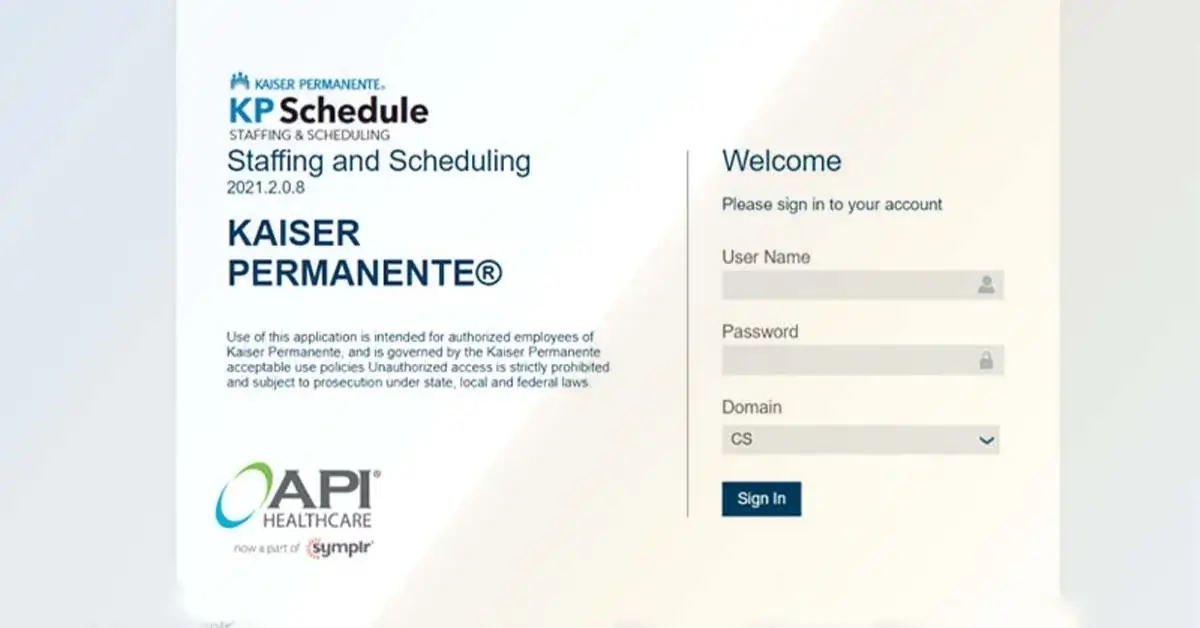Having good health coverage is really important to get the care you need without ending up with huge medical bills. For Kaiser Permanente members, making the most out of your plan means knowing how to use administrative tools like KPschedule. This article will explain KPschedule in detail and how it connects to your health plan benefits, reporting time and attendance, getting authorization from providers, scheduling staff, and other important aspects.
A Synopsis of Kaiser Permanente’s History
Kaiser Permanente (KP) is a big not-for-profit health plan that helps more than 12 million people. They have 39 hospitals and over 800 medical offices in different states. KP is set up as a system where all the care is provided by healthcare professionals who work for the health plan. This makes it easier to coordinate and manage your care efficiently.
To make the most of your KP health coverage, it’s important to understand the details of your plan. Tools like KPschedule can be really helpful in getting to know and use your plan better.
Understanding Your KP Health Plan: The Importance of SBC Documents
Summary of Benefits and Coverage (SBC) documents play a crucial role in helping you make the most of your Kaiser Permanente (KP) health plan. These documents provide a clear overview of key details, such as covered services, cost-sharing information, provider networks, and more. By reviewing your plan’s SBC, you can gain insights into the accessible care options and understand how much you’ll be paying for them.
Why SBCs Matter: Easy Plan Comparison and Transparency
These standardized documents serve as a handy tool when you’re shopping for health coverage. SBCs allow for an easy comparison between different plans. They highlight key exclusions, limitations, and provide examples of potential costs you might face with the plan. This transparency empowers you to choose a plan that aligns with your needs and budget.
How to Access Your SBC Documents: Simple Options for Members
Accessing your SBC documents for your KP plan is a straightforward process. You have a few options:
Online Access via KPschedule Account:
- Log in to your KPschedule account at kp.org.
- Navigate to “Coverage & Costs.”
- Click on “Documents” to view and download your SBCs.
Visit kp.org/sbc
- Select your state and plan.
- Access SBC documents without the need to log in.
Member Services Assistance
- Call member services and request paper copies of your plan’s SBC documents.
Stay Informed: Review Your SBC Annually
To stay up-to-date with your coverage details, it’s essential to review your SBC annually. This can be done during open enrollment or whenever changes occur in your plan. Regularly checking your SBC ensures you have the latest information on your health coverage.
Also Read: Aiotechnical.Com Health: Your Personalized Path To Wellness
Understanding Pay Codes in KPschedule: A Simple Guide
What Are Pay Codes & Why Do They Matter?
In KPschedule, pay codes are like labels that help keep track of time and compensation for Kaiser Permanente (KP) employees. They include earnings codes, shift differentials, overtime codes, and labels for paid time off banks. These codes represent different categories of pay and benefits, and they play a crucial role in determining total earnings for employees.
Setting Up Pay Codes: How It Works
Department admins can log in to KPschedule to create custom pay codes that reflect specific offerings such as incentives, differentials, and stipends. These codes can be linked to rules that specify eligibility, accrual rates, and usage limits. Once set up, IT teams activate these new pay codes to ensure they integrate correctly with the payroll system. This way, workers can log their hours accurately under the right categories for automated earnings calculation.
User-Friendly Customization: User-Defined Categories
KPschedule allows departments to create user-defined categories in addition to system-wide codes. These custom categories help departments tag earnings to specific Cost Center IDs, providing more detailed tracking. While the broad system-defined codes are used for payroll, these custom categories offer added flexibility, allowing for granular tracking and allocation of pay. This flexibility enhances cost tracking and budgeting for better financial management.
Time & Attendance Reporting Made Simple with KPschedule
Efficient Time Card Management: What You Need to Know
In KPschedule, the Time Card Report is your go-to tool for managing employee time cards seamlessly. This feature offers a centralized hub where users can easily view, adjust, approve, and process time entries across different pay categories.
Customize Your View: Filter & Navigate with Ease
Configure filters to display specific subsets of staff, and choose custom date ranges or pay periods for your time card data. This flexibility allows you to audit, update, and sign off on hours logged by individuals or entire departments effortlessly.
Understanding Pay Categories: A Closer Look
For a comprehensive view, optional Time Card Screen views present essential pay code data alongside time cards. The “Pay Categories” tab shows details like accrued, taken, and available hours for earned leave categories. Meanwhile, the “Totals” tab displays cumulative hours, shifts, and estimated earnings for each pay code. Cross-reference this information with time entries to enhance transparency in your records.
Configurable Views for Better Management
These configurable views make it easier to manage benefit time allotments alongside tracked work hours. Whether you need to check individual entries or get an overview of cumulative data, KPschedule’s Time Card Report has you covered, simplifying the process of keeping track of time and attendance.
Exploring Dental Benefits with Kaiser Permanente
Your Dental Plan Options with KP
If you’re a Kaiser Permanente (KP) member, you have access to dental plans that cover routine, basic, and major services, whether you choose in-network or out-of-network options. The specific plans may vary based on your location, but some common options include:
- KP Dental Optimum Plan: This plan provides comprehensive coverage, including orthodontics.
- KP Dental Basic Plan: Offering preventive and basic dental services.
- KP Dental Physician Fee Plan: Coverage for referrals to specialty dental care.
Understanding Your Plan: Check the SBCs
When selecting a dental plan, it’s crucial to review the Summary of Benefits and Coverage (SBCs). These documents provide details about copays, coinsurance, exclusions, and limitations, helping you make an informed decision.
Enrolling in KP Dental Plans: Easy Steps with KPschedule
Whether you’re a new member or an existing one looking to make changes, KPschedule is your tool for managing dental plan enrollment. Here’s how:
- New Members: Enroll via kp.org when signing up for the first time.
- Existing Members: Use KPschedule to enroll or switch plans annually during open enrollment.
- Qualifying Life Events: If you experience a qualifying life event, contact member services to make off-cycle dental plan changes through KPschedule.
Finding Your Dental Provider: A Quick Guide
Visit kp.org/dentist to find in-network dentists near you. The search allows you to filter by location, specialty, gender, languages spoken, and more. You can also check details like office hours, patient experience ratings, and plan acceptance to make an informed choice for your dental care.
Navigating Chiropractor Care Authorization with Kaiser Permanente
Step 1: Finding an Approved Chiropractor
To locate a chiropractor covered by your Kaiser Permanente (KP) plan, follow these simple steps:
- Visit kp.org/chirosearch through KPschedule.
- Enter your location to see nearby in-network chiropractors.
- Review important details about each chiropractor, including credentials, specialty, accepted plans, and reviews.
- Select a well-reviewed chiropractor conveniently located for you.
Step 2: Getting Authorization for Out-of-Network Visits
If you choose an out-of-network chiropractor, it’s essential to obtain prior authorization through KPschedule to ensure coverage. Here’s how:
- Ask your chosen chiropractor to submit a treatment plan and authorization request via KPschedule.
- Provide up-to-date coverage details during this process.
- Check KPschedule for updates on the status of your authorization request.
Once your authorization is approved, you can confidently schedule appointments, knowing you’ll only be responsible for copays or coinsurance.
Step 3: Paying for Chiropractor Services
When checking in for appointments, share your health plan details to access negotiated rates. This helps you avoid higher out-of-network costs. After each visit:
- Pay any owed copays or coinsurance.
- Keep track of payments and visits by reviewing explanations of benefits via KPschedule.
This proactive approach allows you to reconcile billing statements smoothly, ensuring clarity in your chiropractic care payments and coverage.
Understanding KP Staff Scheduling: A Simple Guide
Overview of KPschedule Staff Scheduling
The KPschedule application provides powerful tools for efficiently managing healthcare staff scheduling. Administrators can easily set up shift templates, assign roles to employees, create schedules across various locations and departments, and more. This streamlined system ensures that scheduling data is centralized and seamlessly integrated into payroll and attendance tracking.
Accessing KPschedule Staff Scheduling
For employees, accessing KPschedule is straightforward. Simply log in with your health record number and password at kp.org or through the health plan mobile app. Navigate to “My Schedule” to view your upcoming shifts and explore schedules published up to six weeks in advance, covering multiple departments or locations in one consolidated view.
Administrators have additional tools within KPschedule for building and adjusting schedules, analyzing coverage gaps, and configuring schedule settings, assignments, and workflows.
Key Takeaways for Maximizing Kaiser Permanente Health Coverage
To make the most of your Kaiser Permanente health coverage, it’s crucial to understand administrative systems like KPschedule. Here are some key highlights:
- Review Summary of Benefits & Coverage Documents: Access these documents via KPschedule to understand your plan’s services, costs, and restrictions.
- Configure Personalized Pay Codes: Departments use KPschedule to set up customized pay codes integrated with payroll, ensuring accurate earnings.
- Utilize Time and Attendance Reports: In KPschedule, these reports display consolidated employee time card data for verification.
- Enroll in Dental Plans: Use KPschedule to enroll in dental plans and easily search for in-network dentists.
- Authorize Out-of-Network Chiropractor Care: Obtain authorizations for out-of-network chiropractor care using KPschedule tools.
- Access Staff Schedules: Employees can view their schedules, pick up open shifts, bid for time off, and request changes using KPschedule.
Empower Yourself with KPschedule Knowledge
With a good understanding of KP systems like KPschedule, you can confidently access healthcare services hassle-free. Regularly review your plan’s offerings and administrative tools to stay up-to-date, and don’t hesitate to reach out with any questions.
Also Read: Faa Web Scheduler



